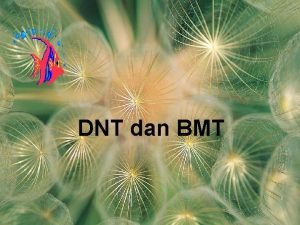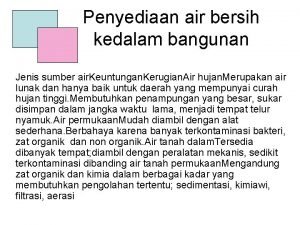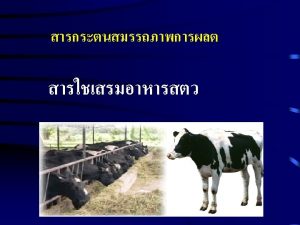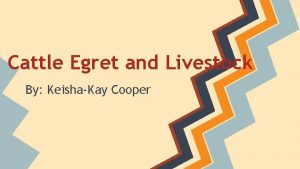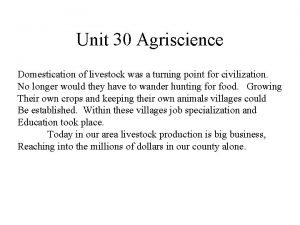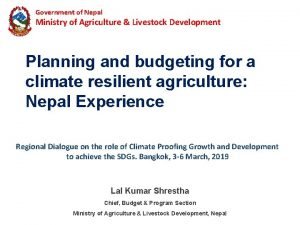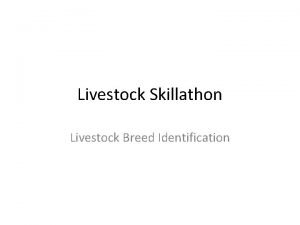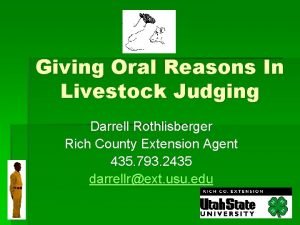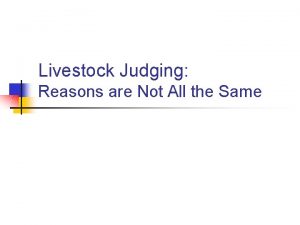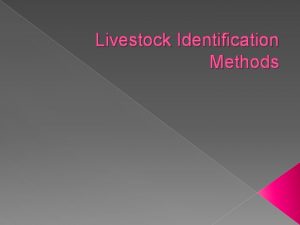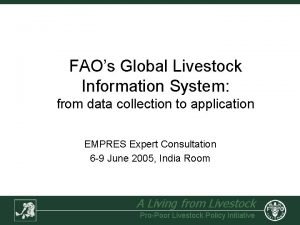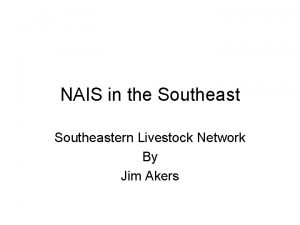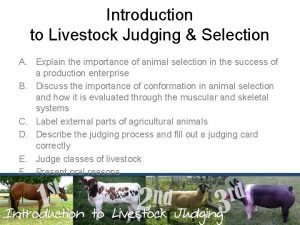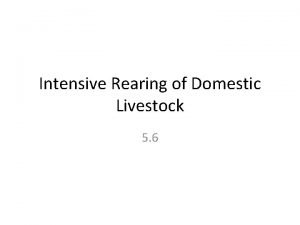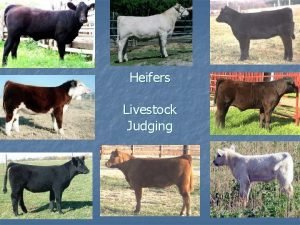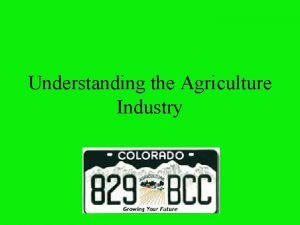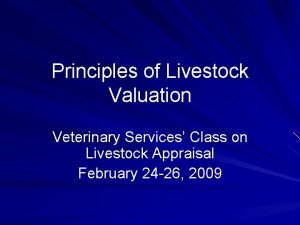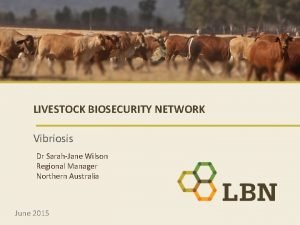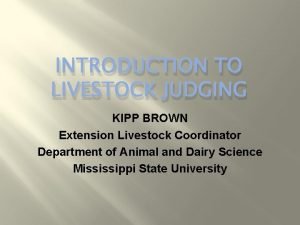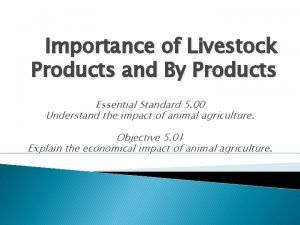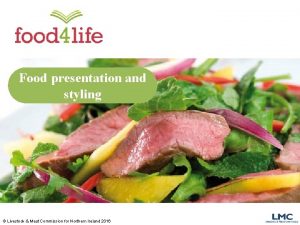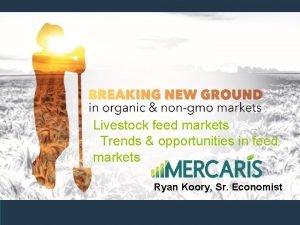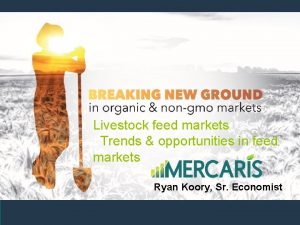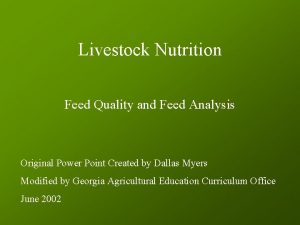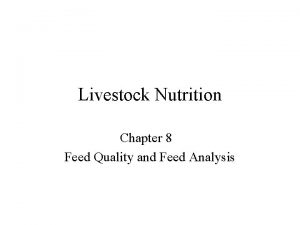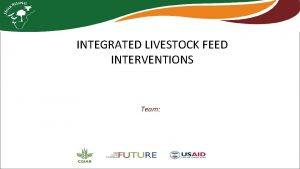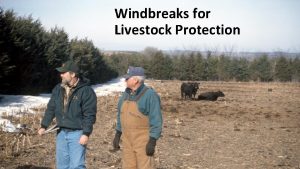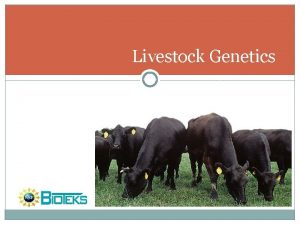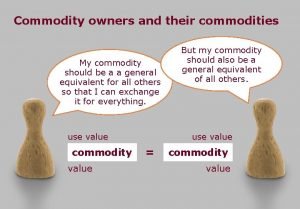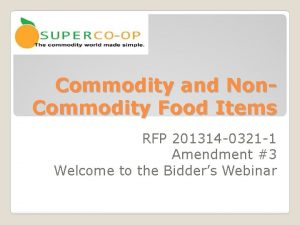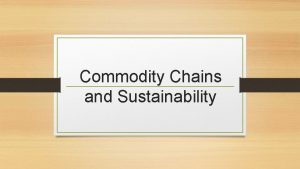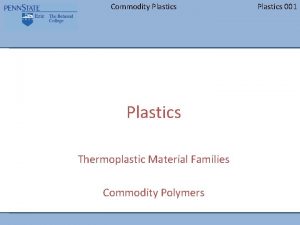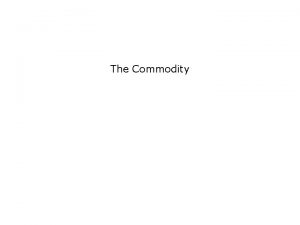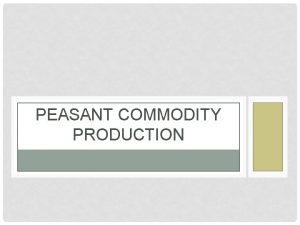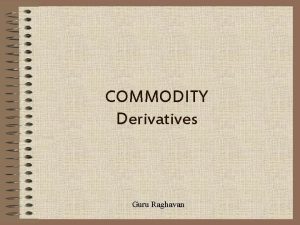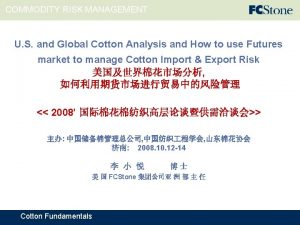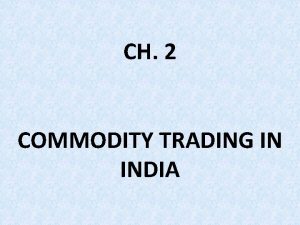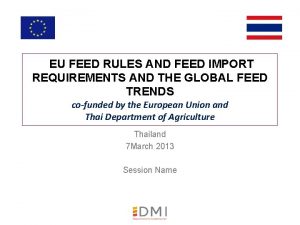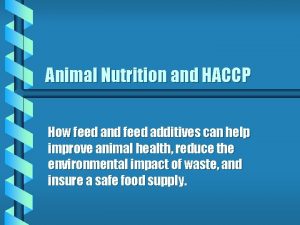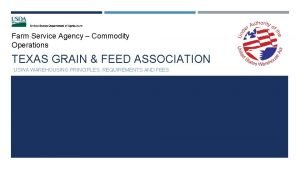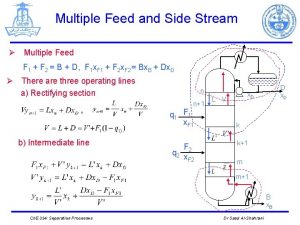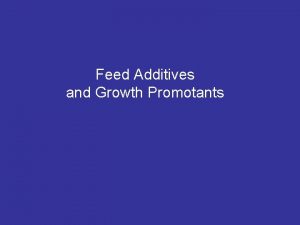What Livestock Commodity Markets Feed and Genetics Have





























- Slides: 29

What Livestock, Commodity Markets, Feed, and Genetics Have in Common

Commodity Markets • What is it? – A physical or virtual marketplace where raw or primary products are bought, traded, and sold. • Raw materials - the basic material from which a product is made – Example: oil or wood – Hard commodity • Primary Products - goods that are available from cultivating raw materials without a manufacturing process – Examples Agricultural, forestry, or fishery products – Soft commodity

Types of Commodities • Hard: Products that are mined or extracted: natural resources that require to be mined or extracted – Example: gold, oil, • Soft: Products that are grown: agriculture products or livestock – Example: corn, soybeans, beef

Current Commodity Markets • Hard Vs. Soft Commodities – Hard commodities dominate over soft commodities because they are easier to handle and have less unpredictable factors that could affect the investment – Soft commodities are most affected by weather and seasons and therefore most likely to have changing values

Livestock and Commodities • Soft Commodities • Meat: – Example: Lean Hogs, Live Cattle, Feeder Cattle, Milk • Crops: – Corn, Soybeans, and Wheat – Corn: typically the largest revenue-generating crop – Soybeans: second largest revenue-generating crop

Current Commodity Markets • Futures Contracts – Selling a future commodity – Finite life (must be sold at agreed upon price on designated date) – Takes advantage of price fluctuations – Contract's price changes relative to fixed trade price creating profits or losses • Changing market – Weather plays a huge factor in productivity • Drought, heat, extreme cold – Seasons play a big part in livestock production • Market value is dependent on the supply level

Cattle and Commodity Markets • The supply level will determine the market value – Supply level given by the USDA • Unpredictable market – Population of cattle available throughout the year affected by different factors – Low reproduction • • Cow: 1 calf per year= 1 calf year/cow Sow: 9 -10 piglets 2 times a year = 20 piglets a year/sow – When corn prices are high • Cattle stay in the pasture longer to avoid increase feed costs – Weather causes cattle to be sent to the feedlot at a lighter weight • • • Drought Extreme heat Live Cattle: – All cattle that are finished and ready to harvest – 1200 -1250 pounds • Feeder Cattle: – All cattle that are ready to go to the feedlot – 6 -8 months old – 600 -800 pounds

Lean Hogs and Commodity Markets • Pro: Less over or underproduction of hogs because: – More commonly raised in a farrow to finish setting – Sows produce 9 -10 piglets twice a year • Predictable market – Pigs are harvested at 6 months of age – If pig birth numbers are low its predictable harvest numbers will be low in 6 months • Lifespan from farrow to finish is shorter than cattle • Feeder Hogs: – 40 -60 pounds • Lean Hogs: – 250 pounds – Approximately 6 months old

Feed Costs • Over 50% of beef cattle production costs are made up of feed costs • Feed Costs vary because of: – Type of ingredients used in the feed – The amount of feed fed per day – Amount of wasted feed • USDA Grain Database – Above website looks at different prices of grains in the United States

Feed Efficiency of Livestock Species • What is feed efficiency? – Definition: measurement between feed consumed by the animal and per pound of live weight put on by the animal • Feed conversion and efficiency is genetic and heritable!

Average Daily Gain • Definition: Rate at which an animal gains weight • Goal: Want the animal to gain the most weight per one pound of feed • Calculated By Average Daily Gain Weight gained (lbs) Avg Daily Gain = Number of days fed (days) – You want a HIGH average • because you want a large number of pounds gained in the least amount of time

Average Daily Gain Example • A lamb’s first weigh-in is 35 lbs. After 100 days on feed the lamb weighs 102 lbs. 1. Average daily gain = Weight Gained ÷ Number of Days Fed 2. Weight gained: 102 - 35 = 67 lbs 3. Average Daily Gain: 67 ÷ 100 = 1. 5 lbs/day 4. ANSWER: Over the 100 days the lamb gained 1. 5 pounds a day

Feed Conversion Ratio • Goal: (1: 1) animal gains one pound per one pound of feed intake – Do NOT want to have to feed a higher number of pounds of feed for 1 pound of weight gain Feed Conversion Ratio = Feed Intake (lbs) Gained Weight (lbs)

Feed Efficiency of Different Species • Which species is the most efficient? FISH! • Cattle(7. 0: 1) • Swine(3. 5: 1) • Sheep(4. 0 -6. 0: 1) • Poultry(2. 0: 1) • Fish (1. 1: 1) – For every 1. 1 pounds fed to a fish they will gain 1 pound – Why are fish so efficient? • Expend less energy on maintaining bodily processes than mammals i. e. , temperature, gravity, excretion

Feed Conversion Ratio Example • A pig is fed 35 pounds of feed and gained 11 pounds. What is the feed conversion ratio of this pig? Feed Conversion Ratio = Feed Intake (lbs) Gained Weight (lbs) 1. Feed Intake = 35 lbs 2. Weight Gained = 11 lbs 3. 35 lbs ÷ 11 lbs = 3. 2 lbs 4. ANSWER: FCR = 3. 2: 1 (The pig gained 3. 2 pounds per 1 pound of feed)

Saving Feed! • How is feed wasted: – – Urine Feces Fermentation gases Use of energy that causes growth • Waste can not be 100% avoided but we can minimize it by: – Feed highly digestible feeds – Feeding supplements that increase production – Improve health and environment conditions • Formulate livestock rations to include low cost feeds or grains

Formulate Rations • Modified algebraic method – works for two unknowns and one nutrient – Step 1: list ingredients on line 1 and the % nutrient on line 2 – Step 2: list amounts of each ingredient on line 3 • Amounts must add up to the amount of diet given in the problem (100 lbs) – – Step 3: set up the equation (multiple line 2 by line 3) Step 4: solve the equation for x Step 5: check your answer Example: Formulate 100 lb of a cattle ration containing 16% CP (crude protein) using corn (8. 9% CP) and a commercial supplement (36% CP). (1) ingredient (2) % CP (3) Amount (lb) (4) equation: corn supplement 8. 9 36. 0 x (100 – x) 8. 9 x + 3600 – 36 x = diet 16. 0 100. 0 1600 ANSWER: x = 73. 8 lb corn, 100 – x = 26. 2 lb supplement (73. 8 + 26. 2 = 100 lbs) (100 lbs of Feed/Ration)

Example of Formulating Rations • Formulate 100 lb of a cattle ration containing 20% CP (crude protein) using sorghum(10% CP) and a commercial supplement (38% CP). (1) ingredient (2) % CP (3) Amount (lb) (4) equation: Sorghum supplement 10 38. 0 x (100 – x) 10 x + 3800 – 38 x = diet 20. 0 100. 0 2000 ANSWER x = 64. 3 lb sorghum, 100 – x = 35. 7 lb supplement

The Beginning of Genetics • Genetics Definition: The study of heredity or how traits pass from parents to their offspring • Gregor Mendel: “Father” of modern genetics – Came up with the terms “recessive” and “dominant” genes – Worked with pea plants • Allowing them to crossbreed (creating hybrids) • Studying: – Plant height, color, and pod shape • Gregor Mendel Inheritance Video – Law of inheritance

Gregor Mendel’s Laws • Law of Inheritance – Law of Segregation • Each parent gives the offspring an allele (total: of 2 alleles) when the offspring creates its own gametes the offspring will randomly receive one of the two alleles – In order for the offspring to express the recessive trait, both alleles MUST both be recessive – Law of Independent Assortment • Different genes are passed down independently from each other – Example: Pea Pod size and Color are independent genes that do not affect each other

Where do Genes come from? • Chromosome: – Rod shaped structure in the nucleus of the cell consisting of genes • DNA: Deoxyribonucleic acid – Nucleic acid containing the genetic information for all living cells • Gene: – Segment of DNA that occupies a specific place on a chromosome that is the basic unit of heredity • Allele: – One form of a gene that has many alternative forms of the same gene in a group of genes

Genetics Breakdown • Research shows that feed efficiency is a moderate to highly heritable trait. • Trait: characteristic passed from parents to offspring • Heredity: capacity of a trait to be passed down from a parent to offspring – Example of High Heritable traits • Scrotal circumference and marbling in meat – Example of Low Heritable traits • Weaning weight and conception rate

Important Terms of Genetics • Dominant Gene: One allele (of the two passed from the parents) that covers the expression of the other allele – A capital letter on the Punnett Square (ex: AA or Aa) • Recessive Gene: An allele whose expression is covered by the dominant allele – Only appears in the offspring if both of the parents give acopy – A lower case letter on the Punnett square – Requires both lower case letters to be expressed by the organism (ex: aa) • Homozygous: two alleles are the same – Either both capital (AA) or both lower case (aa) • Heterozygous: two different Alleles code for the same gene – 1 capital and 1 lower case (Aa)

Important Terms of Genetics • Phenotype: a description of your actual physical characteristics – Coat color, height, milking production • Genotype: the particular the combination of alleles for a particular gene – Example: AA, Aa, or aa • May be homozygous or heterozygous

The Punnett Square • Reginald Punnett – Founder of the Punnett Square • Compares parent genotypes • Used to determine the percentage outcome of characteristics in the offspring – Example: The angus father is heterozygous black (Aa) and the mother angus is homozygous red (aa) what is the percentage that the offspring could be black and what is the percentage the offspring could be red? a a A Aa Aa a aa aa Offspring Percentages 50% Dominant Black 50% Recessive Red

Genetics and Commodities • Animal geneticists help meet demand with animals that are healthy and vigorous as they grow and reproduce and that use nutrients efficiently – Increase production while reducing excess nutrients escaping to the environment – Genes that can enhance animal growth, health, and ability to utilize nutrients

Think It Through • The modern broiler chicken market weight has increased nearly 23 percent compared to the same bird in 1950. – Discuss the possible role genetics has played in this increase. – How might this impact the poultry market?

Think It Through • The number of cattle has decreased over the past decade, yet the total production of beef and milk has increased. – Discuss the possible role genetics has played in this increase. – How might this impact the beef or dairy markets?

References • http: //www. youtube. com/watch? v=0 v. AAf 4 g 5 i. F 8 • http: //www. investopedia. com/terms/c/commodity-market. asp • http: //www. hardassetsinvestor. com/hard-assets-university/18 -hardassets-101 -an-introduction-to-commodities/431 -types-ofcommodities. html? Itemid=4 • http: //www. journalofanimalscience. org/content/22/2/486. abstract • http: //www. omafra. gov. on. ca/english/livestock/sheep/facts/03 -015. htm • http: //anthro. palomar. edu/mendel_1. htm • http: //history. nih. gov/exhibits/nirenberg/HS 1_mendel. htm • http: //www. wvbeef. org/wbtfe. html • http: //www. rjofutures. com/market-news/2012/08/23/understanding-theagricultural-livestock-commodity-markets/ • https: //www. boundless. com/biology/mendelian-inheritance/mendel-slaws-of-inheritance/law-of-segregation--2/
 Feed-up feed-back feed-forward
Feed-up feed-back feed-forward Beate sitek
Beate sitek Perbedaan feed additive dan feed supplement
Perbedaan feed additive dan feed supplement Sistem down feed
Sistem down feed Feed additive dan feed supplement
Feed additive dan feed supplement Cattle egret and cattle symbiotic relationship
Cattle egret and cattle symbiotic relationship Livestock breed identification: swine - vocabulary
Livestock breed identification: swine - vocabulary Ministry of agriculture and livestock development
Ministry of agriculture and livestock development 6 square faces 8 vertices 12 edges
6 square faces 8 vertices 12 edges Livestock breed identification swine - assessment
Livestock breed identification swine - assessment Livestock judging oral reasons
Livestock judging oral reasons Livestock judging powerpoints
Livestock judging powerpoints Livestock risk management brokers near me
Livestock risk management brokers near me Animal kingdom taxonomy chart
Animal kingdom taxonomy chart Livestock identification methods
Livestock identification methods Livestock information system
Livestock information system Parasites of livestock vocabulary
Parasites of livestock vocabulary Livestock network
Livestock network Livestock judging card
Livestock judging card Intensive rearing of livestock
Intensive rearing of livestock Livestock judging basics
Livestock judging basics Colorado agriculture facts
Colorado agriculture facts Livestock valuation methods
Livestock valuation methods Livestock biosecurity network
Livestock biosecurity network Judging 101
Judging 101 Livestock judging basics
Livestock judging basics Livestock breed identification swine - vocabulary
Livestock breed identification swine - vocabulary Livestock meat commission
Livestock meat commission Harmonized commodity description and coding system (hs)
Harmonized commodity description and coding system (hs) Public opinion in pr
Public opinion in pr


